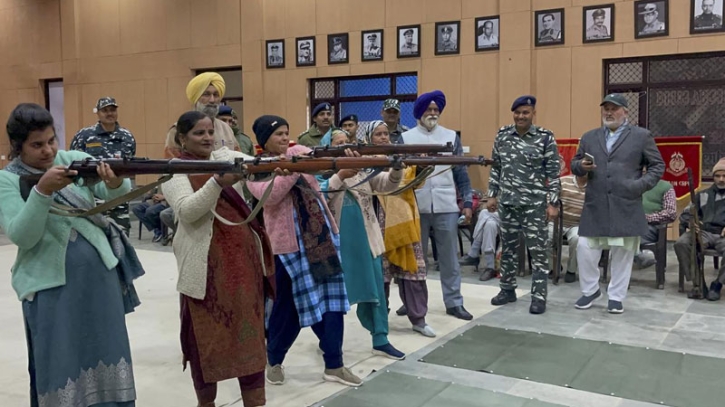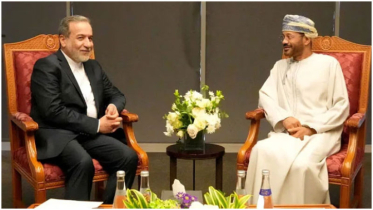India arms civilians in border villages

Amid chants of Bharat Mata ki jai, 23-year-old Anju Devi lifts a .303 bore rifle. Braving the cold and incessant rains, she and 50 other women and men have assembled at a Central Reserve Police Force (CRPF) camp in Jammu’s Sunderbani, close to Pakistan-occupied Kashmir (PoK), to learn how to fire a weapon in self-defence.
In a large hall at the CRPF’s battalion headquarters in Sunderbani in Rajouri district, around 100 km from Jammu city, Head Constable Pradeep lays out a mat and fixes a target board. “Put one foot forward, turn your body 45 degrees and then aim. A .303 rifle is the best weapon for sniping; if the target is within 200-300 metres range, he will surely be shot. But keep changing positions, don’t fire from the same place,” Mr. Pradeep hollers, as men and women listen in rapt attention.
Just a two hour drive away from this place is Dangri village in Rajouri, where seven members of the Hindu community — including two children — were killed in twin terror strikes on the first two days of this year
“We will pick up guns to protect our village, our country. We have to fight the Pakistanis,” says Bacchan Kaur, head of Talatanda village. Ms. Kaur, who has been living in the village for three decades, adds that she wants to aid the police and other armed forces in securing the country.
Among the trainees is Kanchan Kumari, who holds her nine-month-old son Harsh Kumar locked in her arms. She has come from Kuldabi village, around 20 km away, to learn the ropes. The infant babbles as Ms. Kumari fiddles with a rifle. “I have never touched a weapon in my life. We are ordinary farmers. It is better to learn how to fire, it may help in future. We are not scared to die for the country,” she says.
Reviving and retraining VDCs
Ms. Kaur and Ms. Kumari are not isolated voices. Hundreds of villagers in Rajouri and Poonch districts, comprising the Pir Panjal Valley, have been imparted basic arms training by the CRPF and the Army over the past week as part of a government policy to revive village defence committees, which has picked up pace after the Rajouri attack.
Home Minister Amit Shah, however, said on January 13 that the strengthening of the VDCs should not be linked to the Dangri killings. At a press conference in Jammu on Friday, responding to a question from The Hindu about the intention behind giving arms training to civilians, Mr. Shah said, “Do not link the training of VDCs to Dangri killings. A decision was taken at the end of August 2022 to strengthen the VDCs.”
There are strong indications of heightened terrorist activity in the militancy-free Jammu region over the past two years, officials said. Mr. Shah said that the National Investigation Agency and the Jammu and Kashmir police would investigate all terror attacks in the Jammu region over the past one and a half years, adding that a 360 degree security grid would be readied for Jammu over the next three months.
30,000 weapons with civilians
A senior government official said that the pace of training had picked up after the Dangri killings, but noted that the first batch was trained on December 24, 2022. Across Jammu’s districts, including Poonch, Rajouri, Samba, Doda and Kishtwar, the number of weapons with civilians now stands at 30,000, said a senior J&K police officer. They were distributed to civilians by the local administrations in various phases since 1995 when militancy was at its peak in J&K, creating hundreds of village defence committees.
There at least 16 cases pending in various courts against the formation of these VDCs, or Village Defence Guards (VDG) as they are called now. The scheme had to be discontinued in the early 2000s amid allegations of crimes, including abduction and rape, committed by the VDCs.
In Rajouri district, around 500 of 683 previously-registered VDCs have now been revived and retrained, while in Poonch, 100 out of 120 registered VDCs have been retrained. “The idea is to first train the ones who were already allotted weapons and then sensitise others,” a senior J&K police officer said.
‘Armed civilians were in Dangri’
The police officer said that it was difficult to predict the effectiveness of the VDCs. “In Dangri village, per previous records, there are at least 71 individuals with registered weapons provided by police. However, on the day of the incident none fired, though later a man claimed that he fired few rounds from his .303 rifle. Our assessment showed that 27 weapons were either not in use or were locked in iron trunks,” he said.
Two terrorists, who are yet to be identified and caught, had barged into Hindu households in Dangri on January 1 and fired indiscriminately, killing four civilians and injuring 10 others. Within 15 hours, an improvised explosive device went off outside the house of one of the victims, leaving two minors dead and five others injured. A seventh victim succumbed to injuries last week.
The officer noted that in the last 15-years, there has been normalcy in the two districts of Poonch and Rajouri, so there had been no need for people to maintain their weapons.
Lok Nath Sharma, head of Bhajwal village, said that the government may be claiming that militancy has been wiped out, but targeted attacks have increased. “Merely conducting security checks on highways is not enough; it is the VDCs who can provide security in villages,” Mr. Sharma said.
Ex-servicemen step up
Mohan Singh, an ex-serviceman in Talatanda village, said that the government should sanction more sophisticated weapons for civilians. “I retired as a Havaldar in 2003. If a terrorist comes here, we will not let him escape. BSF [Border Security Force] is at the border, we will stand guard here, act as a buffer,” said Mr. Singh, adding that he served in the infantry division and could be put to good use.
His neighbour and cousin Gurnam Singh, who retired as Captain from the Army adds, “SLR rifles should be given to those who have retired from the Army. In 1996, one of the villagers, an army jawan who was here on leave, helped to kill six militants. Today also we have the same spirit. Since I was in artillery division, I can fire shells with ease if need arises at the border,” he said.
The police officer said that plans are afoot to provide Self Loading Rifles (SLRs) to ex-servicemen.
At Sunderbani, Deputy Commandant Ashok Kumar cautions the villagers that a civilian had been injured in Poonch two days ago while handling a rifle. “It is necessary to maintain and properly clean the rifle. Always keep the nozzle blocked with a piece of cloth,” Mr. Kumar explains.
‘Empowering citizens’
A senior government official said that the government was not absolving itself of responsibilities by arming civilians. “A State is empowered to empower its citizens. There are three aspects to this: protection, confidence building of a community, and visibility of armed people that could act as a deterrence in case of an attack,” the official said.
Ashwini Sudhyal, a 23-year-old police aspirant, has other concerns. “I live on the zero line on Pakistan border. I trekked six kilometres on foot before catching a bus to reach this place. It took me an hour. Can you request the government to build a road to my village? Self-defence training is fine but what about our basic necessities?” Mr. Sudhyal asked.
Source: The Hindu
.png)




